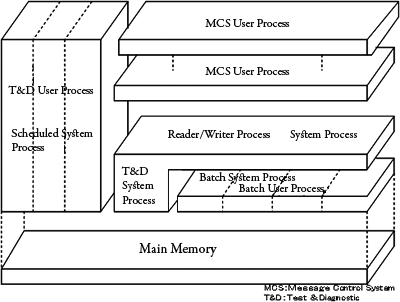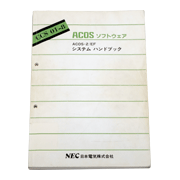NEC announced ACOS-2/EF in April 1983 and started shipping it in October of that year.
ACOS-2/EF functioned as the operating system for ACOS System model 410, which adopted a CMOS gate array for the element and a pipeline-control, 4-way processor technology for the central processing unit. With a view to expansion of operations processed by the computer from conventional data processing (DP processing) to office operations, the OS enabled a usage style in which DP processing and OA processing were integrated.
Features of its major functions included:
(1) Dynamic Main Storage Management Function to Enable Multiprocessing
The OS provided a logical hierarchical structure that enabled the user to effectively use the main storage. To the user, the main storage would appear to consist of many layers, and he/she could start a program as long as the layer in which the batch process operated had free space, even though the MCS (Message Control System) process layer might have had no free space. The right to use the main storage was managed through priority; a program was controlled according to its operating characteristics (e.g., online performance, batch performance) and operating status (e.g., reception queue, IO queue), and effective allocation control was performed throughout the system. This operating system was capable of performing multiprocessing of up to 250 tasks.
The OS provided a logical hierarchical structure that enabled the user to effectively use the main storage. To the user, the main storage would appear to consist of many layers, and he/she could start a program as long as the layer in which the batch process operated had free space, even though the MCS (Message Control System) process layer might have had no free space. The right to use the main storage was managed through priority; a program was controlled according to its operating characteristics (e.g., online performance, batch performance) and operating status (e.g., reception queue, IO queue), and effective allocation control was performed throughout the system. This operating system was capable of performing multiprocessing of up to 250 tasks.
(2) Provision of RIQS (Relational Information Query System) for Use by End Users and for Easy System Development
RIQS was a relational database designed basically for ease of use, flexible response to change and fast operation. Its features included:
RIQS was a relational database designed basically for ease of use, flexible response to change and fast operation. Its features included:
- Simple tabular data structure that anyone could understand.
- Tables were independently managed and maintained, and interrelation of data could be performed according to data values, and dynamically.
- Provided a READ/WRITE-type RIQS-DML that allowed direct access to table data from a high-level language, enabling access to table data as with conventional standard files.
((3) Provision of an Organized Software Development Support System
Based on the software engineering architecture SEA/I (Software Engineering Architecture/One), the OS provided an organized software development support system from the following situations with the aim of improving maintainability by preparing an environment in which a large number of quality software programs could be created in a short period in order to achieve efficient development of critical operations mainly performed in the computer room.
Based on the software engineering architecture SEA/I (Software Engineering Architecture/One), the OS provided an organized software development support system from the following situations with the aim of improving maintainability by preparing an environment in which a large number of quality software programs could be created in a short period in order to achieve efficient development of critical operations mainly performed in the computer room.
- An environment for creating an interactive program based on a nonprocedural language IDL (Integrated Data-oriented Language)
- Provision of an environment, parts and patterns that allowed a program to be developed by the component
- Test tools including a test status identification tool ATAC (Automatic Test Activity Checker)
- A product management support system that had a function for centrally managing program products and a documentation function
(4) Provision of Integrated Office System “Aladdin”
The OS realized a virtual office environment comprising the operator, filing cabinet, desk, documents, files, mailbox, trash bin, etc. on the computer. The aim was to provide a computer system that would more closely emulate human behavior in an actual office. Through interactive operation using icons, the OS allowed the user to perform simple business tasks with the same feeling and procedures as if he/she were doing actual deskwork.
In addition, Aladdin provided a comprehensive range of basic office functions through “Decision Support Partner,” which supported business decision-making; “Office Work Partner,” which supported document processing and data processing; and “Office Communication Partner,” which supported communication.
The OS realized a virtual office environment comprising the operator, filing cabinet, desk, documents, files, mailbox, trash bin, etc. on the computer. The aim was to provide a computer system that would more closely emulate human behavior in an actual office. Through interactive operation using icons, the OS allowed the user to perform simple business tasks with the same feeling and procedures as if he/she were doing actual deskwork.
In addition, Aladdin provided a comprehensive range of basic office functions through “Decision Support Partner,” which supported business decision-making; “Office Work Partner,” which supported document processing and data processing; and “Office Communication Partner,” which supported communication.




